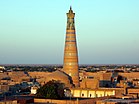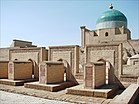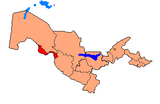Khiva
Khiva
Xiva / Хива | |
|---|---|
Clockwise from top: Itchan Kala,Alla Kouli Khan Madrasa, Pakhlavan Makhmoud Mausoleum, Islam Hoja Minaret, Muhammad Amin Khan Madrasa and Kalta Minor | |
| Coordinates:41°22′53″N60°21′40″E/ 41.38139°N 60.36111°E | |
| Country | |
| Region | Khorazm Region |
| Founded | 6th century BC |
| Government | |
| • Hakim | Temur Davletov |
| Population (2021)[1] | |
| • Total | 115 000 |
| Postal code | 220900 |
| Area code | +998 |
| Website | https://xivashahar.uz/ |
Khiva(Uzbek:Xiva,Хива,خیوه;Persian:خیوه,Xīveh;alternative or historical names includeOrgunje,Kheeva,Khorasam,Khoresm,Khwarezm,Khwarizm,Khwarazm,Chorezm,Arabic:خوارزمandPersian:خوارزم) is a district-level city of approximately 93,000 people inKhorazm Region,Uzbekistan.[2]According to archaeological data, the city was established around 2,500 years ago. In 1997, Khiva celebrated its 2500th anniversary.[3]It is the former capital ofKhwarezmia,theKhanate of Khiva,and theKhorezm People's Soviet Republic.Itchan Kalain Khiva was the first site inUzbekistanto be inscribed on theWorld Heritage List(1991). The astronomer, historian and polymath,Al-Biruni[4](973–1048 CE) was born in either Khiva or the nearby city ofKath.
Etymology[edit]
This sectionneeds additional citations forverification.(October 2023) |
The origin of the name Khiva is unknown, but many contradictory stories have been told to explain it.
A traditional story attributes the name to one of the sons of the prophetNoah:"It is said thatShem,after the flood, he found himself wandering in the desert alone. Having fallen asleep, he dreamt of 300 burning torches. On waking up, he was pleased with this omen, he founded the city with outlines in the form of a ship mapped out according to the placement of the torches, about which he had dreamt. Then Shem dug the Kheyvak well, the water from which had a surprising taste. It is possible to see this well in Ichan-Kala (an internal town of Khiva City) even today. "[5]
Another proposal is that the name comes from the wordKhwarezm,altered by borrowing into Turkic as Khivarezem, then shortened to Khiva.
History[edit]
In the early part of its history, the Aryan inhabitants spoke anEastern Iranian languagecalledKhwarezmian.Turksreplaced the Iranian ruling class in the10th centuryAD, and the region gradually turned into an area with a majority ofTurkicspeakers.
Russia annexed theKhanate of Khivain the 19th century. The last khan from the ruling dynasty was liquidated a century later, in 1919. Thus Khiva became the capital city of the newKhorezm People's Soviet Republic.The Khorezm oasis was converted into a part of modern Uzbekistan and Turkmenistan in 1924.[6]
The earliest records of the city of Khiva appear in Muslim travel accounts from the 10th century although archaeological evidence indicates habitation in the 6th century; by the early 17th century, Khiva had become the capital of the Khanate of Khiva.[7]The khanate was ruled by a branch of theAstrakhans,aGenghisiddynasty.

In the 17th century, Khiva began to develop as aslave market.For several centuries, the cities of Bukhara and Khiva were known as major centers of the slave trade, and theBukhara slave trade,alongside the neighboringslave trade in Khiva,has been referred to as the "slave capitals of the world".[8]During the first half of the 19th century, around 30,000Persiansand an unknown number ofRussians,were enslaved there before being sold. A large part of them were involved in the construction of buildings in the walledItchan Kala.[7]
Campaigns[edit]
In the course of theRussian conquest of Central Asia,in 1873 theRussianGeneralKonstantin von Kaufmanlaunched an attack on the city of Khiva, which fell on 28 May 1873. Although theRussian Empirecontrolled the Khanate, it allowed Khiva to remain as a nominally quasi-independentprotectorate.
Following theBolshevikseizure of power in Russia after theOctober Revolutionof 1917, a short-lived (1920-1924)Khorezm People's Soviet Republicformed out of the territory of the old Khanate of Khiva before its incorporation into theUSSRin 1924. The city of Khiva became part of theUzbek Soviet Socialist Republic.
Sights[edit]

Khiva is split into two parts. The outer town, called Dichan Kala, was formerly protected by a wall with 11 gates. The inner town, orItchan Kala,is encircled by brick walls, whose foundations are believed to have been laid in the 10th century. Present-day crenellated walls date back to the late 17th century and attain the height of 10 meters.
Kalta Minor, the large blue tower in the central city square, was supposed to be a minaret. It was built in 1851 byMohammed Amin Khan,but the Khan died and the succeeding Khan did not complete it.
The old town retains more than 50 historic monuments and 250 old houses, mostly dating from the 18th or 19th centuries. Djuma Mosque, for instance, was established in the 10th century and rebuilt in 1788–89, although its celebratedhypostylehall still retains 112 columns taken from ancient structures.[9]
Khiva was home to a number ofmadrassahs(educational establishments), one of which, Sherghazi Khan madrassah, still stands today. It was built in the 18th century by slaves and is one of the oldest buildings in Ichan-Kala, which is the center of present-day Khiva. Among the renowned students of the madrassah were theUzbekpoet Raunaq, theQaraqalpaqpoet Kasybayuly, theTurkmenpoet andsufiMagtymguly.[10]
Industry and production[edit]
In the town, activities such as the "KhivaCarpet" joint-stock company, cotton cleaning, ginning factories, carpet weaving, the "Khiva Gilami" joint-stock company, and other carpet weaving enterprises, as well as a bread factory, a farmer's market, cultural, trade, and service establishments are operational. There are branches ofUrgenchUniversity specializing in agro-management, theUzbek Academy of SciencesKhorezmMamun Academy, the Qoraqum Scientific Research Station, pedagogical, medical, and tourism colleges, vocational lyceums, a gymnasium, 15 general education schools, a house of culture, 2 special boarding schools, a regional puppet theater, an art school, 2 libraries and their branches, and cultural and recreational gardens.[11][12]
The central hospital, polyclinic, maternity hospital, children's hospital, dental treatment center, central pharmacy, specialized clinics, and other medical facilities are available in the district. Historical and architectural sites in the area include:
the Sayd Alauddin mausoleum, thePahlavon Mahmud Complex,theJuma Mosque,theOld Ark,Oqshayx Bobo's Palace,Toshhovli Palace,Nurullabai Palace,Muhammad Aminxon Madrasah,Muhammad Rahimxon Madrasah,Islamkhodja Madrasahand Minaret,Olloqulixon Madrasah,Qutlughmurad Inoq Madrasah,Olloqulixon Caravanserai and its market, Anushakhan Bathhouse,Oq Mosque,Polvon Gate,Ota Gate,Bogcha Gate,Tosh Gate,Hazorasp Gate, Kush Gate,and more.[13][14][15]
The town publishes the "Khiva-Sharq Gavhari" magazine (since 2001) and the "Khiva Tongi" district newspaper. The town is a prominent center for global tourism, attracting over 200,000 tourists every year, including nearly 7,000 international visitors. "O'zbekTurizm" national company operates in the town, and several private guesthouses are in operation.
A trolleybus line was established from Khiva toUrgenchin 1997. Bus and minibus routes connect Khiva toTashkent,Bukhara,Navoi,Samarkand,Urgench,Qo'shko'pir,Yangiariq,Bog'ot,Hazorasp,and other major cities and population centers in the region.[16]
Archaeological and cultural significance[edit]
Khwarazmoccupies a special place in the list of values of universalimportanceas a major center ofworld civilizationand one of the important centers on theSilk Road.
The unique values of world significance include architectural monuments of Khiva, which has rightfully earned thetitleof "museum city".
The image of modern Khiva is mainly formed by thearchitectureof the period ofKhiva Khanateof the late XVIII - early XX centuries.
Butarchaeological excavationsunderway here show that at the base of a number of relatively "young" remains ofbuildingsare ancient layers dating back to the III and even earlier centuries BC.
Overview of architectural monuments of Khiva[edit]
Most of Khiva's architecturalmasterpiecesare concentrated in itsurban core-Itchan Kala.It is a "city within a city" surrounded by powerfulfortress wallswith four gates on each side of the world.
One of the mainhighwaysruns from the westerngateto the eastern gate, along which the main monumentalbuildingsare concentrated.
From theobservation towerof Ak-Sheikh-boboItchan-Kalacan be seen like in the palm of your hand. The unusual silhouette of the Kalta Minorminaretattracts attention, as if cut down to the middle.
Its massive trunk, exquisitely decorated with wide and narrow belts of glazedbrick,indicates that it was conceived as a grandiose, majesticstructure,the main vertical of the city.
But after the death of thekhan,under whom the minaret was built, it remained unfinished, receiving the name of Kalta (short).
Very close to the Kalta Minar is the Muhammad AminxonMadrasah,the largest of the preserved buildings of higher theologicaleducational institutions.
The peculiarity of its architecture is the twin hudjras -cellsfor living ofstudents.Belts of colored brick sets andmajolicafacings decorate the building wonderfully.
On the territory ofKonya Ark(OldFortress) there is the palace of Muhammad Rahimxon I with rich and unusualinterior decoration.
The walls of thehallare decorated with ganch carving with coloring. The neighboring two-storied building is aharem.There are many rich chambers, living rooms.
TheJuma Mosque(X century, 1788) is amazing in its beauty. On the entrance doors the date of construction - 1778-1782 years is preserved.
But 210columnsof themosque,supporting theroof,are much older - from XII to XV centuries. The columns are remarkable for their amazing slenderness, rich ornamental carving.
They were brought here from other ancient buildings, so many columns are unique and do not resemble each other.
At the gates of Polvon darvoza there is a whole ensemble of buildings. The main palace ofKhiva khansToshhovli occupies a special place here.
Thearchitectureof its numerous apartments and decorative furnishings are unique. There are ornamentalwood carvings,majolicafacings and figurativecartouches.
Thepalaceof Kurnysh-khan was intended for lavish receptions. Once there was a woodenthronein thethrone roomdecorated withsilverchasingon a red background.
The building has a beautifuliwanwith columns. The palace is also remarkable for its rich majolica wall lining with intricateornaments.
The Pahlavon Mahmud Memorial Complex was built in memory of the revered Khivapoet,who after his death was canonized as thepatron saintof the city.
Nearby is the 45-meter high Islomxo‘ja minaret topped with a through lantern with adomeon top. In the outer part of the city - Dishan qalʼa - there are also many ancient architectural monuments.
Notable people from Khiva[edit]
The following people were born in the city.
- Tamara Abaeva(born 1927), historian.
- Sayid Abdullah(1873–1933), Khan of Khiva 1918–1920.
- Khudaibergen Devanov(1879–1940), photographer.
- Islam Khodja(1872–1913), Grand Vizier of the Khanate of Khiva.
- Israil Madrimov(born 1995), boxer.
- Bekjon Rakhmonov(1887–1929), politician.
- Palvanniyaz Khodja Yusupov(1861–1936), politician.
- Muhammad Rahim Khan II of Khiva,Khan of Khivafrom 1864 to 1910
Sister cities[edit]
The following is a list of Khiva's sister and twinned cities:
 Ankeny, Iowa,United States (2023)
Ankeny, Iowa,United States (2023) Nishapur,Iran
Nishapur,Iran Yazd,Iran(2020)
Yazd,Iran(2020) San Lorenzo del Escorial,Spain(2019[17])
San Lorenzo del Escorial,Spain(2019[17])
See also[edit]
- Al-Khwarizmi
- Bukhara
- Slavery in Asia#Central Asia and the Caucasus
- Trolleybuses in Urgench
- Abdolbobo Mausoleum
References[edit]
- ^"Viloyat bo'yicha shahar va qishloq aholisi soni"[Urban and rural population in the region] (PDF) (in Uzbek). Xorazm regional department of statistics.Archivedfrom the original on 2023-03-22.Retrieved2022-02-15.
- ^"Classification system of territorial units of the Republic of Uzbekistan"(in Uzbek and Russian). The State Committee of the Republic of Uzbekistan on statistics. July 2020.Archivedfrom the original on 2022-07-02.Retrieved2022-02-15.
- ^В. А. Булатова, И. И. Ноткин, Архитектурные памятники Хивы. (Путеводитель), Ташкент, 1972; Хива. (Архитектура. Фотоальбом), Л., 1973; Г. Пугаченкова, Термез, Шахрисябз, Хива, (М„ 1976).
- ^Patrologia Orientalis Tom. Decimus, p.291https://archive.org/details/patrologiaorient10pariuoft
- ^Nashriyoti, Davr (2012).Khiva: The City and the Legends.Tashkent, Uzbekistan: Davr Nashriyoti LLC. p. 2.ISBN9789943339262.
- ^"khiva".Archivedfrom the original on 2021-05-09.Retrieved2021-03-09.
- ^ab"Khiva".Encyclopædia Britannica. May 16, 2018.Archivedfrom the original on August 2, 2020.RetrievedJune 20,2020.
- ^Mayers, K. (2016). The First English Explorer: The Life of Anthony Jenkinson (1529-1611) and His Adventures on the Route to the Orient. Storbritannien: Matador. p. 121
- ^"Khiva Travel Guide".Caravanistan.Archivedfrom the original on 2021-04-22.Retrieved2021-03-13.
- ^"Shergazi-Khan Madrasah, Khiva".Advantour.Archivedfrom the original on 2021-05-15.Retrieved2021-06-17.
- ^"ANATOLIY YERSHOV. XIVA — QO'RIQXONA SHAHAR (1988)".ziyouz.18 August 2016.Archivedfrom the original on 2023-10-29.Retrieved2023-10-31.
- ^"Xudoybergan Devonov - birinchi o'zbek fotografining boy ijodi va ayanchli qismati".kun.uz.Archivedfrom the original on 2023-10-30.Retrieved2023-10-31.
- ^"Xiva".uztarix.narod.ru.Archivedfrom the original on 2023-10-30.Retrieved2023-10-31.
- ^"Xiva – o'tmishga ochilgan vaqt darvozasi".otpusk.uz.Archivedfrom the original on 2023-10-29.Retrieved2023-10-31.
- ^"Fotojamlanma: Xiva - Jahon merosi durdonasi joylashgan shahar".kun.uz.Archivedfrom the original on 2023-10-30.Retrieved2023-10-31.
- ^"ANATOLIY YERSHOV. XIVA — QO'RIQXONA SHAHAR (1988)".Xiva.Archivedfrom the original on 2023-10-30.Retrieved2023-10-31.
- ^"Khiva and San Lorenzo del Escorial have become sister cities".Archivedfrom the original on 2021-07-29.Retrieved2021-02-13.
Publications[edit]
This article includes a list of generalreferences,butit lacks sufficient correspondinginline citations.(April 2012) |
- Campaigning on the Oxus, and the Fall of Khiva,MacGahan, (London, 1874).
- A Ride to Khiva: Travels and Adventures in Central Asia,Frederick Burnaby,(OUP, 1997; first published 1876).
- Russian Central Asia,Lansdell, (London, 1885).
- A travers l'Asie Centrale,Moser, (Paris, 1886).
- Russia against India,Colquhoun, (New York, 1900).
- Khiva,in Russian, S. Goulichambaroff, (Askhabad, 1913).
- A Carpet Ride to Khiva,C. A. Alexander, (London, 2010).
External links[edit]
- Slave trade in Khiva
- Beyond the Bazaars: Geographies of the slave trade in Central Asia
 Khivatravel guide from Wikivoyage
Khivatravel guide from Wikivoyage











